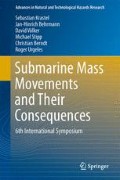Abstract
Submarine landslides on open continental slopes can be far larger than any slope failure on land and occur in locations worldwide on gradients of <2°. Significantly elevated pore pressure is necessary to overcome the sediment’s shearing resistance on such remarkably low gradients, but the processes causing such overpressure generation are contentious, especially in areas with slow sedimentation rates. Here we propose that the progressive loss of interparticle bonding and fabric could cause such high excess pore pressure. Slow sedimentation may favour the formation of a structural framework in the sediment that is load-bearing until yield stress is reached. The bonds then break down, causing an abrupt porosity decrease and consequently overpressure as pore fluid cannot escape sufficiently rapidly. To test this hypothesis, we implement such a loss of structure into a 2D fully coupled stress-fluid flow Finite Element model of a submerged low angle slope, and simulate consolidation due to slow sedimentation. The results suggest that destructuring could indeed be a critical process for submarine slope stability.
Access this chapter
Tax calculation will be finalised at checkout
Purchases are for personal use only
References
Binh NTT, Tokunaga T, Nakamura T, Kozumi K, Nakajuma M, Kubota M, Kameya H, Taniue M (2009) Physical properties of the shallow sediments in late Pleistocene formations, Ursa Basin, Gulf of Mexico, and their implications for generation and preservation of shallow overpressures. Mar Petrol Geol 26:474–486
Di Prisco C, Matiotti R, Nova R (1995) Theoretical investigation of the undrained stability of shallow submerged slopes. Géotechnique 45(3):479–496
Dugan B, Flemings PB (2000) Overpressure and fluid flow in the New Jersey continental slope: implications for slope failure and cold seeps. Science 289:288–291
Flemings PB, Long H, Dugan B, Germaine JT, John CM, Behrmann JH, Sawyer DE et al (2008) Erratum to “pore pressure penetrometers document high overpressure near the seafloor where multiple sub- marine landslides have occurred on the continental slope, offshore Louisiana, Gulf of Mexico”. Earth Planet Sci Lett 274:269–283
Hattab M, Favre JL (2010) Analysis of the experimental compressibility of deep water marine sediments from the Gulf of Guinea. Mar Petrol Geol 27(2):486–499
Hühnerbach V, Masson DG et al (2004) Landslides in the North Atlantic and its adjacent seas: an analysis of their morphology, setting and behaviour. Mar Geol 213:343–362
Kominz MA, Patterson K, Odette D (2011) Lithology dependence of porosity in slope and deep marine sediments. J Sediment Res 81(10):730–742
Liu MD, Carter JP (1999) Virgin compression of structured soils. Géotechnique 49(1):43–57
Locat J, Lee HJ (2002) Submarine landslides: advances and challenges. Can Geotech J 39:193–212
Locat J, Tanaka H, Tan TS, Dasari GR, Lee HJ (2003) Natural soils: geotechnical behavior and geological knowledge. In: Tan TS et al (eds) Characterisation & engineering properties of natural soils, vol 1. A.A. Balkema Publishers, Lisse, p 3
Masson DG, Harbitz CB, Wynn RB, Pedersen G, Løvholt F (2006) Submarine landslides: processes, triggers and hazard prediction. Philos Trans R Soc 364:2009–2039
Powrie W (2002) Soil mechanics. Spon, London
Skempton AW, Northey RD (1952) The sensitivity of clays. Géotechnique 3:30–52
Sumner E., Siti MI, McNeill L, Talling PJ, Henstock TJ, Wynn RB, Djajadihardja Y, Permana, H (2013) Can turbidites be used to reconstruct a palaeoearthquake record for the central Sumatran margin? Geology. http://dx.doi.org/10.1130/G34298.1
Tanaka H, Locat J (1999) A microstructural investigation of Osaka Bay clay: the impact of microfossils on its mechanical behaviour. Can Geotech J 36(3):493–508
Twichell DC, Chaytor JD, ten Brink US, Buczkowski B (2009) Morphology of late quaternary submarine landslides along the U.S. Atlantic continental margin. Mar Geol 264:4–15
Urlaub M (2012) The role of sedimentation rate on the stability of low gradient submarine continental slopes. PhD thesis, University of Southampton, Southampton
Urlaub M, Zervos A, Talling PJ, Masson DG, Clayton CI (2012) How do 2° slopes fail in areas of slow sedimentation? A sensitivity study on the influence of accumulation rate and permeability on submarine slope stability. In: Yamada Y et al (eds) Submarine mass movements and their consequences. Springer, Dordrecht, pp 277–287
Acknowledgements
We would like to thank the reviewers Jean-Sebastien L’Heureux and Jacques Locat for their thoughtful reviews.
Author information
Authors and Affiliations
Corresponding author
Editor information
Editors and Affiliations
Rights and permissions
Copyright information
© 2014 Springer International Publishing Switzerland
About this chapter
Cite this chapter
Urlaub, M., Talling, P., Zervos, A. (2014). A Numerical Investigation of Sediment Destructuring as a Potential Globally Widespread Trigger for Large Submarine Landslides on Low Gradients. In: Krastel, S., et al. Submarine Mass Movements and Their Consequences. Advances in Natural and Technological Hazards Research, vol 37. Springer, Cham. https://doi.org/10.1007/978-3-319-00972-8_16
Download citation
DOI: https://doi.org/10.1007/978-3-319-00972-8_16
Published:
Publisher Name: Springer, Cham
Print ISBN: 978-3-319-00971-1
Online ISBN: 978-3-319-00972-8
eBook Packages: Earth and Environmental ScienceEarth and Environmental Science (R0)

